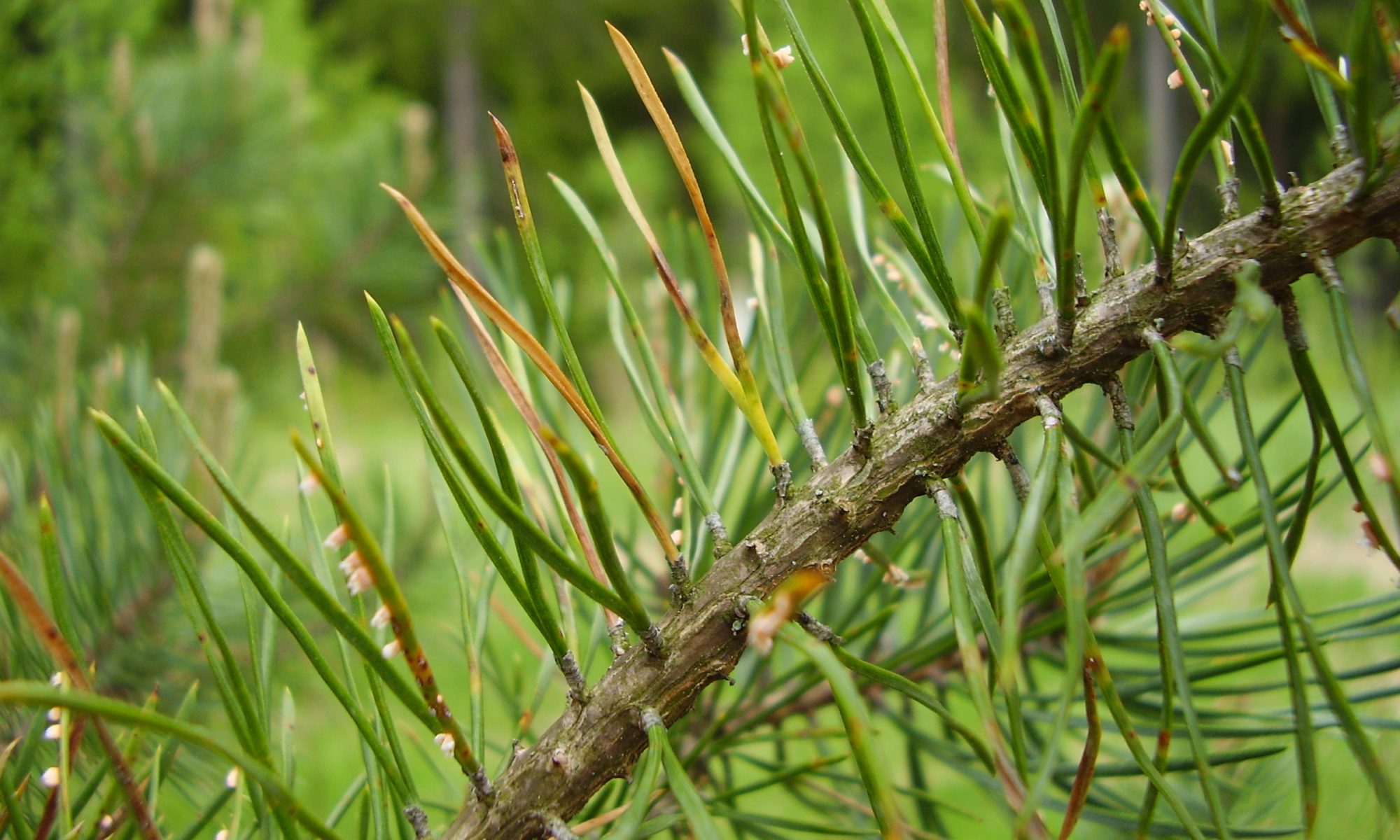————————————————————————————————
Juha Honkaniemi
Root rot (Heterobasidion annosum s.l. Fr.(Bref.)) and bark beetles (Ips typographus L.) are the most important biotic damage factors in Norway spruce forests in southern Finland. Increasing wind damages have increased bark beetle outbreaks in Fennoscandia. Especially sensitive for the wind damages are root rot infested Norway spruce stands. In such areas, the economical losses can be significant for single forest owner. The use of silvicultural methods can however affect the losses caused by Heterobasidion, wind and bark beetles. The first objective of my research is to develop a method and software to simulate and predict the dynamics and development of root rot, wind and bark beetle damages within forest stand. This model software will be included in MOTTI (http://www.metla.fi/metinfo/motti/index-en.htm) stand scale simulation software. The main objective is to quantitatively describe the silvicultural methods affecting the forest damages and the economical losses caused by these damages. The effects of different control methods against Heterobasidion annosum and silvicultural control cuttings against bark beetle damages to forest growth, the extent of the damages and the profitability of forestry will be studied. The research will enhance forestry operational preconditions and timber usage because wider knowledge in the damage risks and their predictability will result in better preparation and control against damages and thereafter to better timber quality and silvicultural outcome. The research results will benefit private forest owners, forestry companies, insurance companies and financial institutions; hence the research will increase the knowledge on the risks for forests as an investment.
I work at the Finnish Forest Research Institute METLA. http://www.metla.fi/pp/8731/index-en.htm
email: juha.honkaniemi (at) metla.fi
————————————————————————————————
 Heterobasidion species are economically the most important fungal pathogens in Finland and boreal forests in general, their pathology is strongly dependent on mycelial growth and transmission from tree ( or stump) to tree. Virus with dsRNA genomes designated as Heterobasidion partitiviruses/viruses (HetPV/HetRV) are found in approximately 15-17% of H. annosum s. lat. isolates in Europe and western Asia. They transmit laterally between Heterobasidion strains through anastomosis and vertically via basidiospores and conidia. Heterobasidion partitiviruses seem to cross species barriers easily and their effects may differ considerably in different Heterobasidion hosts. Notably, while most of the partitiviruses are more or less cryptic, we have recently identified some partitivirus strains that considerably restrict the growth of their hosts. The research project is mainly focused on understanding the interplay among different viruses and their Heterobasidion host species. The genetically and phenotypically diverse mycovirus community inhabiting Heterobasidion annosum provides an excellent model system to analyze (i) virus-host interactions, (ii) virus-virus interactions, (iii) virus recombinations, as well as to test (iv) novel species concepts for fungal viruses.
Heterobasidion species are economically the most important fungal pathogens in Finland and boreal forests in general, their pathology is strongly dependent on mycelial growth and transmission from tree ( or stump) to tree. Virus with dsRNA genomes designated as Heterobasidion partitiviruses/viruses (HetPV/HetRV) are found in approximately 15-17% of H. annosum s. lat. isolates in Europe and western Asia. They transmit laterally between Heterobasidion strains through anastomosis and vertically via basidiospores and conidia. Heterobasidion partitiviruses seem to cross species barriers easily and their effects may differ considerably in different Heterobasidion hosts. Notably, while most of the partitiviruses are more or less cryptic, we have recently identified some partitivirus strains that considerably restrict the growth of their hosts. The research project is mainly focused on understanding the interplay among different viruses and their Heterobasidion host species. The genetically and phenotypically diverse mycovirus community inhabiting Heterobasidion annosum provides an excellent model system to analyze (i) virus-host interactions, (ii) virus-virus interactions, (iii) virus recombinations, as well as to test (iv) novel species concepts for fungal viruses.
Based on our recent findings related to potential virus species, the main future objective on the long run would be to create opportunities to establish a virus-based biocontrol system to overcome infections on forest trees caused by Heterobasidion species. This research is being conducted mainly at forest pathology lab (Prof. Jarkko Hantula), the Finnish Research Institute METLA (http://www.metla.fi/pp/8770/index-en.htm) and partly collaborated by plant pathology lab (Prof. Jari Valkonen), Department of Agricultural Sciences, University of Helsinki.
Email: muhammad.kashif (at) metla.fi
————————————————————————————————
Ximena Silva
 Forest tree microbiome using Eucalyptus as a case study
Forest tree microbiome using Eucalyptus as a case study
Fungi associated to plants or trees are hyperdiverse, but unlike in temperate countries not much is known about fungal biodiversity in the tropics. Equally, very little is known about their ecological impact on nutrient cycling and co-evolution with their host tree species, particularly in Paraguay. Of especial interest are those that associate with native species of families like Myrtacea, famously known for the genus Eucalyptus, used world-wide in forest plantations. Forest plantations require considerable amount of investment and Eucalyptus is a fast growing species. Initially, these plantations were not only offering the advantage of fast growth but they were relatively not affected by diseases of native local tree species. However, in recent times, fungal diseases of Eucalyptus plantations have become increasingly common. This endangers forest production, particularly in areas where little is known about the local microbes. This research focuses on one of the world’s major biodiversity hotspots, the Atlantic forest region of Paraguay. It targets scarcely studied fungal communities to uncover how they impact forest tree health as well as carbon sequestration and nutrient cycling. My intention is to explore the mycota biodiversity on native Myrtaceae in Paraguay in order to explain variability through spatial and environmental factors, and compare them to introduced, non-native timber tree species. For that, I will sample sympatric introduced and native species in Paraguay. Samples from designated forest sites will be collected. After isolation, the DNA will be pyrosequenced and analysed. In parallel, direct culturing will be used to obtain isolates to be used for pathogenicity testing.
ximena.silvapalacios (at) helsinki.fi
————————————————————————————————
Zhen Zeng
 In our project, 17 isolates of the Heterobasidion annosums and 24 isolates of the H. parviporum were obtained from infected tree tissues or fruiting bodies in Finnish forests from 16 and 21 geographic locations respectively. The pathogenicity level of these isolates will be determined. The four isolates classified as having the highest and the lowest pathogenicity in H. annosum s.s. and H. parviporum respectively will be selected for de novo genome sequencing. Genome assembly, annotation and comparative genomic analysis will be carried out to find out the pathogenicity-specific regions in both Heterobasidion species.
In our project, 17 isolates of the Heterobasidion annosums and 24 isolates of the H. parviporum were obtained from infected tree tissues or fruiting bodies in Finnish forests from 16 and 21 geographic locations respectively. The pathogenicity level of these isolates will be determined. The four isolates classified as having the highest and the lowest pathogenicity in H. annosum s.s. and H. parviporum respectively will be selected for de novo genome sequencing. Genome assembly, annotation and comparative genomic analysis will be carried out to find out the pathogenicity-specific regions in both Heterobasidion species.
Afterwards, selected isolates will be incubated on different substrates (liquid media for free-living growth, dead wood chips for saprotrophic growth and living trees for necrotrophic growth). Samples will be taken to isolate total RNA for RNA-seq followed by comparative analysis of the transcriptomes of the mycelia between different trophic strategies in the same isolate and between the isolates of different pathogenicity.
Samples growing on three different substrates will be taken for genomic DNA isolation as well for Methylated DNA immuno-precipitation combined with DNA microarray (MeDIP-chip) to obtain DNA methylation profiles. Comparative analysis of the methylation profiles will be performed. This will allow us to understand the role of DNA methylation in the life style switches as well as in the pathogenicity of Heterobasidion.
————————————————————————————————
Zilan Wen
Heterobasidion parviporum Niemelä & Korhonen is one major pathogen on Norway spruce and cause root and buff rot. The reference genome sequence for H. parviporum revealed a repertoire of secreted proteins with potential contributions to virulence. I am studying the role of small secreted proteins (effectors) elicited by phytopathogenic fungi in modulating plant or tree defence responses. In my research, I focus on small screted proteins from Heterobasidion parviporum (HpSSP). My responsibility is to identify putative HpSSPs from H. parviporum genome with transient expression in Nicotiana benthamiana and expression analysis of genes encoding HpSSPs during infection.


